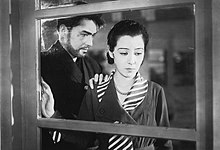No Blood Relation
| No Blood Relation | |
|---|---|
 Jōji Oka and Yoshiko Okada | |
| Japanese name | |
| Kanji | 生さぬ仲 |
| Directed by | Mikio Naruse |
| Written by |
|
| Starring |
|
| Cinematography | Suketaro Inokai |
Production company | |
| Distributed by | Shochiku |
Release date |
|
Running time | 79 minutes[1] |
| Country | Japan |
| Language | Japanese |
No Blood Relation (生さぬ仲, Nasanu naka) is a 1932 Japanese silent drama film directed by Mikio Naruse, based on a novel by Shunyo Yanagawa.[1][2][3] It is the first surviving feature-length film by the director.
Plot
[edit]After five years overseas, star actress Tamae returns to Japan to reunite with her daughter Shigeko, whom she left behind with her then husband Atsumi in favour of her career. In her absence, Atsumi has married again, and the bond between Shigeko and her stepmother Masako has grown as strong as between a blood-related child and mother. When Atsumi's company goes bankrupt and his family is forced to move to lower-class surroundings, Tamae sees her chance to lure Shigeko away, but eventually has to accept that her wealth can't compensate for Shigeko's and Masako's mutual love.
Cast
[edit]- Yoshiko Okada as Tamae Kiyooka
- Shin'yō Nara as Shunsaku Atsumi
- Yukiko Tsukuba as Masako, Atsumi's wife
- Toshiko Kojima as Shigeko, Atsumi's daughter
- Fumiko Katsuragi as Kishiyo, Atsumi's mother
- Jōji Oka as Masaya Kusakabe
- Ichirō Yūki as Keiji Makino
- Shozaburo Abe as "Gen the Pelican"
Analysis
[edit]Naruse biographer Catherine Russell linked No Blood Relation to other Naruse films of the same era like Three Sisters With Maiden Hearts, Wife! Be Like a Rose! and The Girl in the Rumor, by using the popular but controversial figure of the moga (modern Japanese girl with Western values and Western fashion style), who contrasted with another woman or sister.[4]
Legacy
[edit]No Blood Relation was screened at the Cinémathèque Française in 2006[5] and at the Berlin International Film Festival in 2007 in its "Retrospektive" program.[6]
References
[edit]- ^ a b c "No Blood Relation". Japanese Movie Database (in Japanese). Retrieved 19 February 2021.
- ^ "生さぬ仲 (No Blood Relation)". Kinenote (in Japanese). Retrieved 19 February 2021.
- ^ Goble, Alan (1999). The Complete Index to Literary Sources in Film. Walter de Gruyter. p. 513. ISBN 978-3-11-095194-3.
- ^ Russell, Catherine (2008). The Cinema of Naruse Mikio: Women and Japanese Modernity. Durham and London: Duke University Press. pp. 115–116. ISBN 978-0-8223-4290-8.
- ^ "Nasaku naka". Cinémathèque Française (in French). Retrieved 19 July 2023.
- ^ "Nasanu naka". Berlinale.de. Retrieved 25 October 2022.
External links
[edit]- No Blood Relation at IMDb
- Scanlon, Hayley. "No Blood Relation". Windows on Worlds. Retrieved 19 February 2021.
- Blakeslee, David (27 August 2012). "A Journey Through the Eclipse Series: Mikio Naruse's No Blood Relation". criterioncast.com. Retrieved 19 February 2021.
Text is available under the CC BY-SA 4.0 license; additional terms may apply.
Images, videos and audio are available under their respective licenses.
